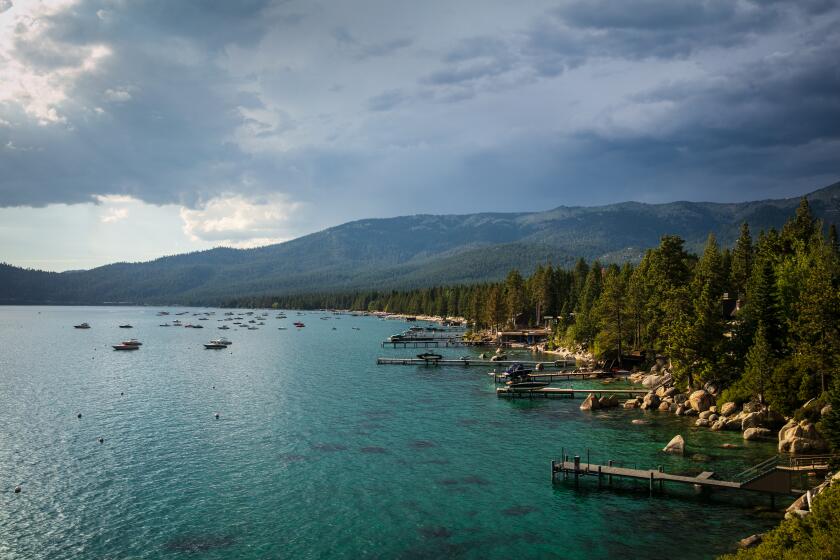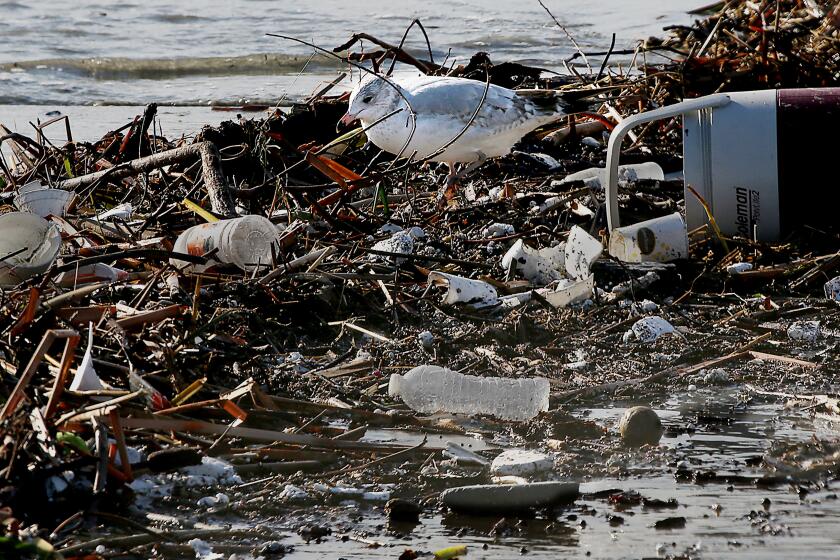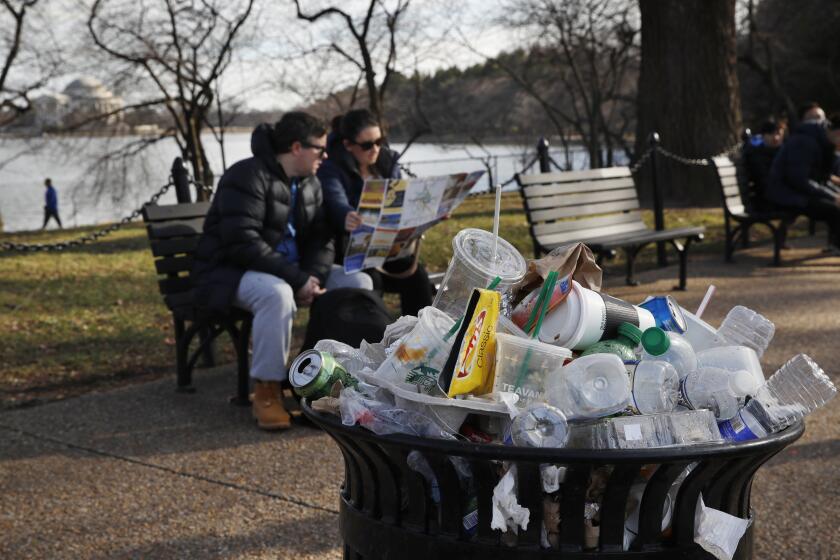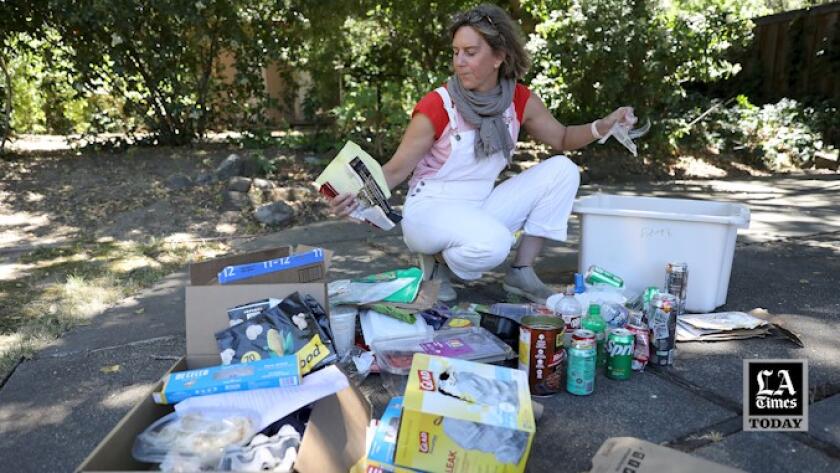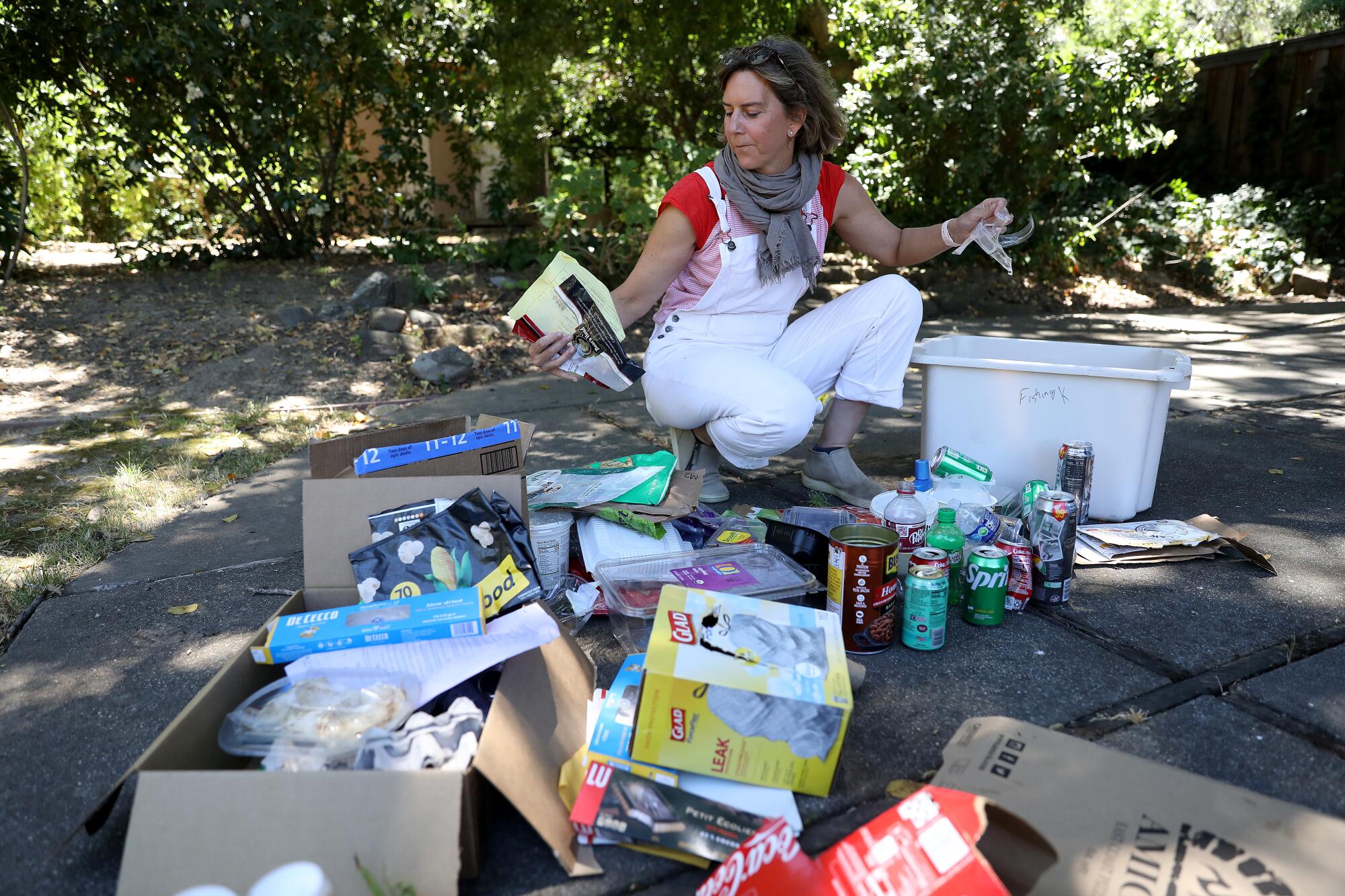
- Share via
Plastic is everywhere.
It’s in our bodies: our lung tissue, our blood and in the dark, tarry first defecation of newborns. It’s been discovered in the deepest recesses of the ocean and in the snow of pristine alpine peaks and meadows. It’s in the wind, in the dust, in the air we breathe and in our drinking water and food.
Small bits and minuscule strings of plastic have become so pervasive and omnipresent that they now cycle “through the earth in a manner akin to global biogeochemical cycles,” such as water, carbon, nitrogen or oxygen. Microplastics evaporate from the ocean and land, then get picked up by the jet stream before being deposited on our trees, crops, rivers and lakes. From there, the cycle starts again.
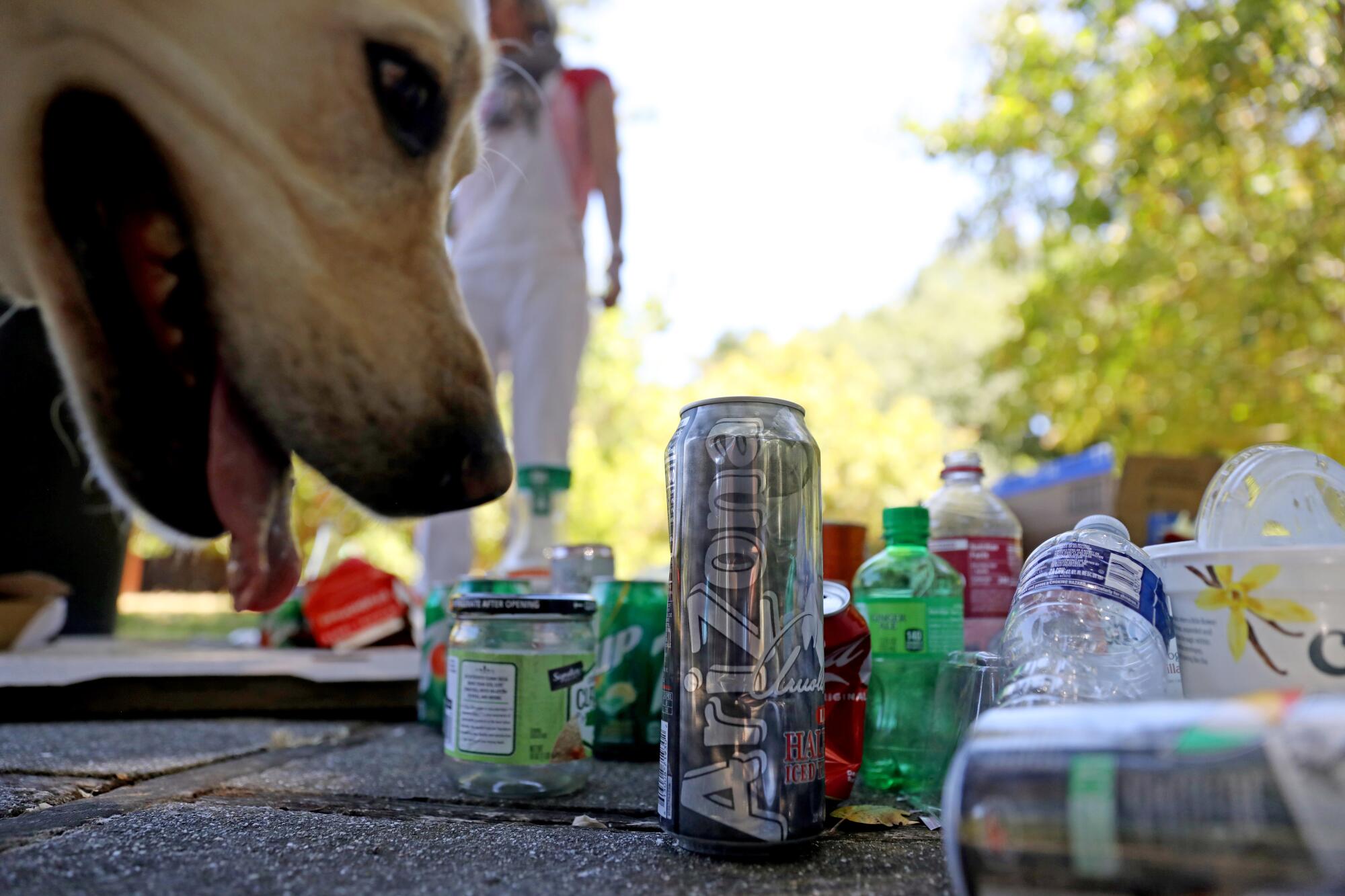
Then there are the horrifying statistics about the petroleum byproduct’s ubiquity: By the year 2050, there’s going to be more plastic by weight in the ocean than fish; every week a person consumes five grams, or a credit card’s worth, of plastic; and on average, we pass about 800 to 1,000 plastic bits a day in our poop.
If the Golden State is going to lead the world toward a better, safer future, our political and business leaders — and the rest of us — will have to work harder to rewrite the California narrative. Here’s how we can push the state forward.
And despite growing public awareness, economists estimate the production of plastic will continue to grow as product manufacturers and the packaging industry find new and innovative ways to wrap plastic swim goggles on store shelves, or separate carrots in the supermarket grocery aisle.
The problem is, because plastic never fully decomposes — it just breaks down into smaller and smaller bits — the more we produce and purchase, the more we allow in our bodies, in our water and our air. It just keeps piling up.
In fact, research suggests the largest producer of microplastics into our atmosphere is our oceans. Why? Because for 50 years, these bodies of water have accumulated a continually growing pile of plastic waste. And we’ve dumped so much that as the material breaks down — and floats to the surface — it evaporates into the air and drifts with the wind to land.
As an environment reporter, I am acutely aware of the problem. I read about it constantly and worry about it frequently. I also work hard to minimize the amount of plastic to which I am exposed. And I thought I was pretty good at it. Until I agreed to this assignment.
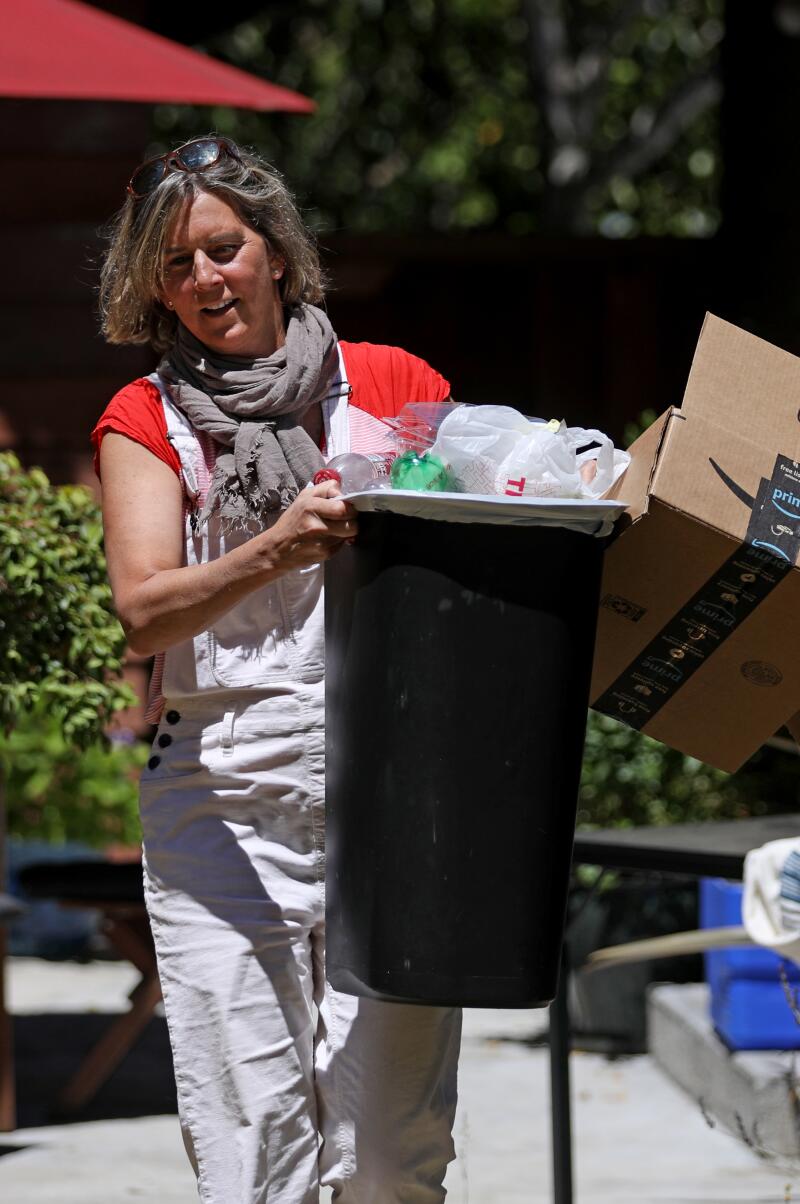
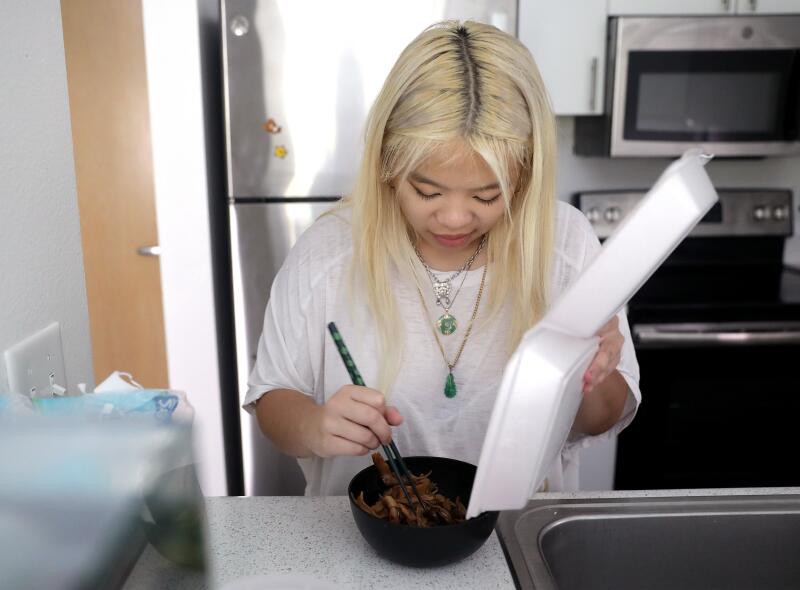

1. The Times asked three sets of family units to save their waste — including plastics — for a week. Susanne Rust said her first attempt at chronicling her daily plastic interactions overwhelmed her. (Gary Coronado / Los Angeles Times) 2. M.O., 22, warms up leftover noodles for a recent lunch. (Christina House / Los Angeles Times) 3. Jennifer Ho, left, and Edward Gonzales at home in La Crescenta. They use cloth diapers for their 7-month-old son, Sage, compost their food scraps and recycle nearly everything else, but the week reminded them that more needs to be done systemically to help communities minimize waste. (Christina House / Los Angeles Times)
At some point this spring, an editor from The Times called and we talked about the possibility of me writing a story about plastic, and maybe setting aside a week and chronicling my daily plastic interactions.
In June, I made my first attempt and was immediately overwhelmed; just taking stock of my desk environment had me reconsidering my plastic self-awareness.
Here’s an excerpt: “Clippy for my hair; airpods case; plastic on tea kettle; windows are glass, but casings are vinyl; bird decals on windows (to keep birds from striking the glass); computer casing; monitor; CO2 monitor (with windows open, it’s reading 459 ppm); cordless phone charger; all the USB cords on my desk; mouse; mouse pad; cone around dog’s head (he just had surgery); clip on his “lick sleeve”; my belt is clearly some sort of non-natural product; my prana pants are a petroleum by-product, for sure.”
I suppose I could be excused for listing nondisposable, non-single use plastics — which environmentalists suggest are really the scourge — but the following day, I realized I had a problem there too.
I was traveling from San Francisco to Montreal. There was no escaping single-use plastics in the airport or on the airplane.
A study of 38 lakes and reservoirs in 23 countries found that Lake Tahoe had the third-highest concentration of microplastics.
While waiting at the gate, my husband went to get us some food for the flight. He returned with three plastic, clamshell boxes containing healthy, organic food.
On the plane, even though I’d brought a steel cup for beverages, the flight attendant poured my drink into a single-use plastic cup, before pouring the contents into my cup. I sat there and calculated the waste from this one flight: roughly 120 people on board, with most getting two drinks — so, let’s say 200 plastic cups. (And that’s not counting the meals, which are all wrapped in a plastic shrink-wrap.) Multiply that by the estimated 100,000 flights on any given day — and you get the picture.
But even back home, I couldn’t escape the plastic. Buying pasta for dinner? Guess what, the box of the spaghetti brand I enjoy most has a plastic “window” cut out of the cardboard box. The chicken I bought for a curry dish? Wrapped in plastic and on a polystyrene tray.
I sat there and calculated the waste from this one flight: roughly 120 people on board, with most getting two drinks. ... Multiply that by the estimated 100,000 flights on any given day — and you get the picture.
When I went to shop for produce, I ordinarily would have bought a box of organic leafy greens — which come in a plastic, single use clamshell-type container. But, mindful of all the plastic I was collecting in my shopping cart, I elected instead to buy heads of lettuce and spinach. Fortunately, my local grocery store has “compostable” plastic bags for produce; a luxury not available at the larger chain supermarket I usually shop at (because it’s cheaper).
Editorial: California is leading the nation on cutting plastic trash. But it still needs to do more
Even as California passes new laws to reduce single-use plastic trash, new sources of plastic are quickly filling the void. It’s time to shift focus.
And it didn’t end there. I took stock of the equipment I use for exercise. I’m a swimmer. And everything I use for swimming is either plastic, or some form of petroleum byproduct: goggles; swim cap; suit; swim buoy; fins; paddles; swim bag.
Reporter Susanne Rust catalogued her plastic use for a week. There was one activity that involved far more plastic than she realized: swimming.
Even in my own body, I have plastic — and not the microplastics I mentioned above. Two, C-cup sized patties of plastic.
I’m a breast cancer survivor and had a double mastectomy several years ago. I chose to get reconstructive surgery and now have two plastic implants under my skin and pressed against my chest wall.
Looking at the accumulation of plastic my family and I had amassed over the week — I live with my husband and together we have five teenagers — it was hard to not get overwhelmed.
Which isn’t to say there aren’t a lot of wonderful things about plastic. It makes my car lighter, and therefore more energy efficient. Its lightweight and durable properties make it an excellent material to wear on my head in the form of a helmet when I bicycle. And I know that when I order things online for delivery (a habit I knew was bad, but hadn’t fully appreciated until I took stock that week of the waste I’d accrued), the reduced weight makes it more energy-sparing than other materials and is less likely to get damaged.

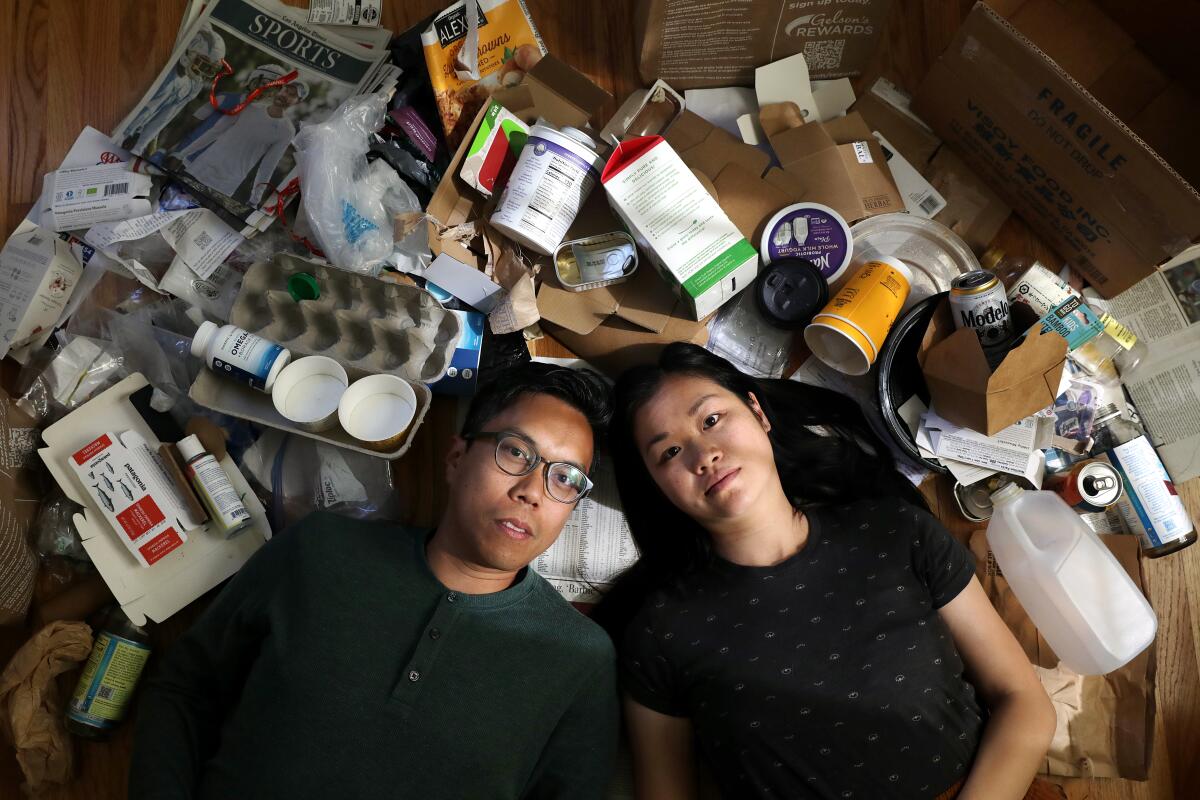
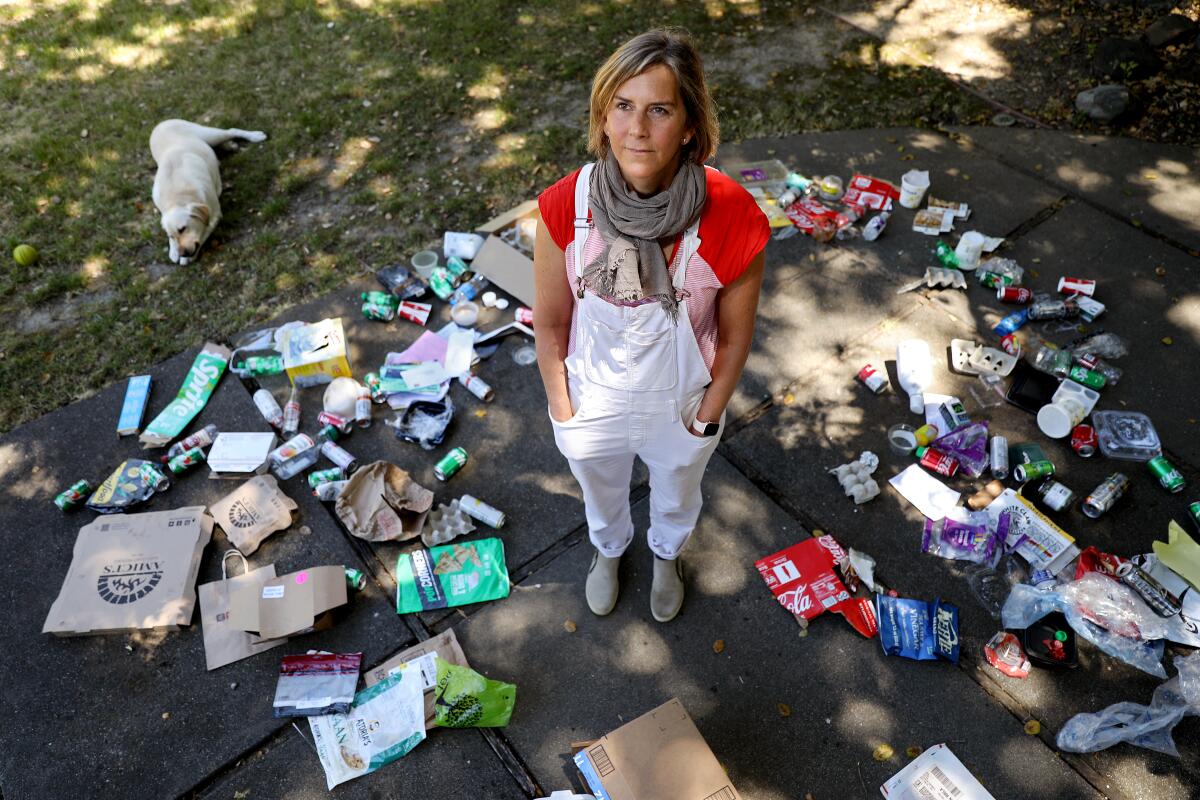
1. M.O. recently moved to a new apartment in downtown Los Angeles. (Christina House / Los Angeles Times) 2. Gonzalez and Ho say they take care to think about the plastics and papers they get rid of, “but recycling still has an aspect of ‘out of sight, out of mind.’ ” They own two tumblers for their compost, which they consider an important resource for their garden, having started separating out their scraps a few years ago. (Christina House / Los Angeles Times) 3. Rust writes: “Activists and environmentalists say we can work to contain our plastic footprint. But it’s almost impossible to avoid it altogether — especially for people who have other time commitments during the day, such as work, kids, hobbies, a need to exercise.” (Gary Coronado / Los Angeles Times)
But there’s clearly too much out there. And statistics and research suggest that no amount of recycling is going to get us out of this mess.
U.S. studies show that only about 5% of the more than 50 million tons of annual plastic waste gets recycled. Fifty million tons of plastic is roughly the same weight as 25 million cars; that’s almost twice the number of cars registered in California.
Activists and environmentalists say we can work to contain our plastic footprint; we can try to buy food products that only come in paper, cardboard, glass or aluminum. But as I learned this week, it’s almost impossible to avoid it altogether — especially for people who have other time commitments during the day, such as work, kids, hobbies, a need to exercise.
The legislation heads off what would be a costly and contentious ballot measure and pushes California ahead of the world in the fight against plastic waste.
Some lawmakers have decided to step in and try to make a dent, and environmentalists are hopeful government pressure can make a change where voluntary cutbacks by plastic producers and packaging companies don’t. The business of plastic is lucrative: In 2022, the plastic industry was valued at more than $600 billion, and projected to grow.
For instance, last summer, California lawmakers passed SB 54, which requires that by 2032, 100% of packaging in the state must be recyclable or compostable; plastic packaging must be reduced by 25%; and 65% of all single-use plastics must be recycled.
According to the Ocean Conservancy, the 25% packaging reduction could eliminate nearly 46 billion pounds of single-use plastics over the next decade.
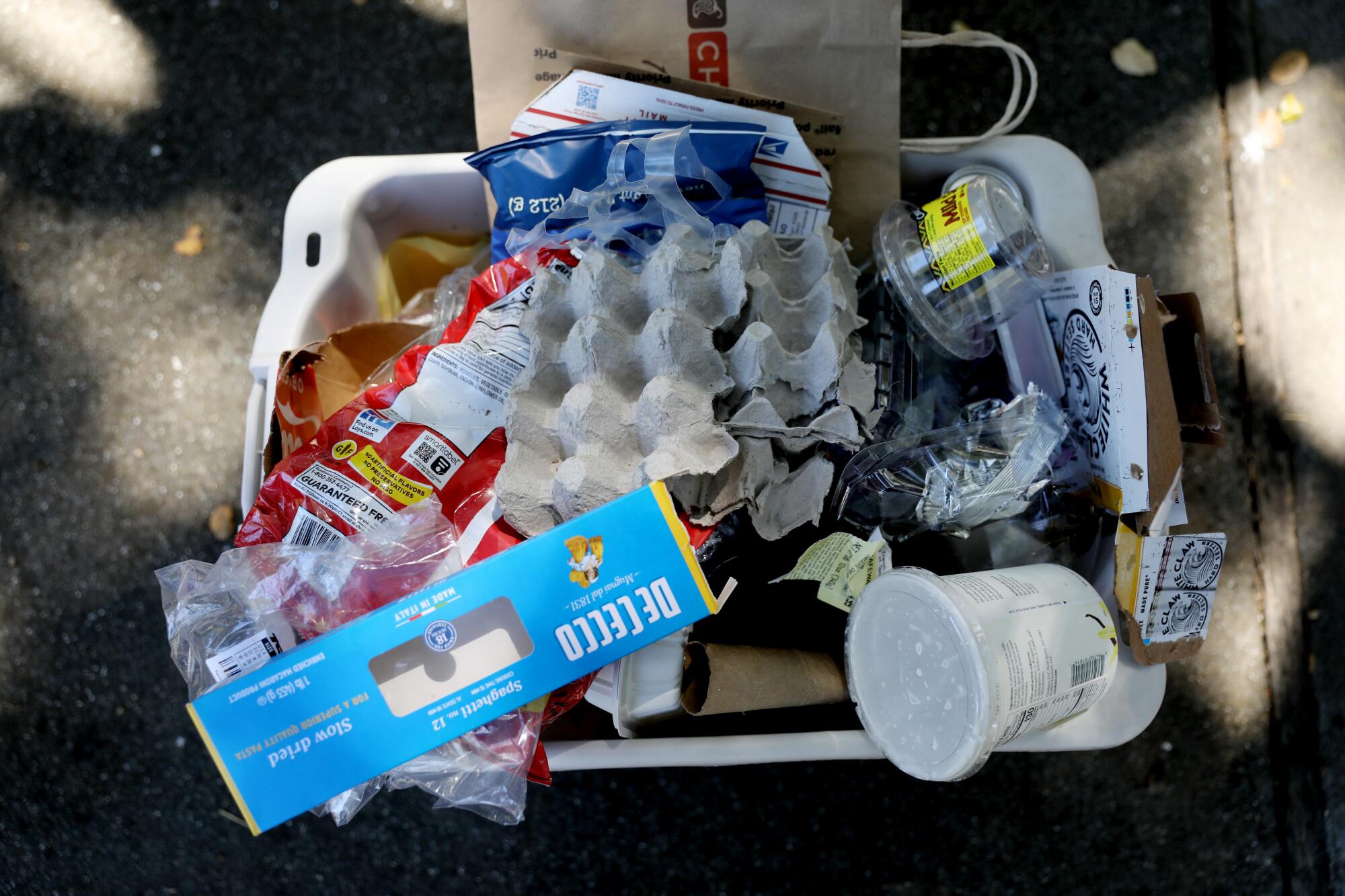
Other states, including Washington, are looking at similar legislation. And more than a dozen have banned plastic bags — the poster children of wasteful, single-use plastics.
In addition, California’s Atty. Gen. Rob Bonta launched a first-of-its kind investigation last year into the fossil fuel and petrochemical industries over their alleged role in causing and exacerbating a global crisis in plastic waste pollution.
In the meantime, researchers are trying to understand the health implications of having microplastics in our bodies. They know associated additive and plasticizer compounds — such as bisphenol A and phthalates — have been linked to illness and disease in humans and animals.
Environmentalists say it’s hard not to get discouraged. But they also point to a growing awareness and consumer consciousness they believe could staunch the flow of plastics into our water, air, soil and bodies.
We live in a world where convenience is expected, and the consequences of that lifestyle are largely hidden from us. But people are beginning to see — one journal entry at a time.
Ask a Reporter: Inside the project
What: Times reporters Rosanna Xia and Sammy Roth will discuss “Our Climate Change Challenge” during a live streaming conversation. City Editor Maria L. LaGanga moderates.
When: Sept. 19 at 6 p.m. Pacific.
Where: This free event will be live streaming. Sign up on Eventbrite for watch links and to share your questions and comments.
- Share via
Watch L.A. Times Today at 7 p.m. on Spectrum News 1 on Channel 1 or live stream on the Spectrum News App. Palos Verdes Peninsula and Orange County viewers can watch on Cox Systems on channel 99.
More to Read
Sign up for Essential California
The most important California stories and recommendations in your inbox every morning.
You may occasionally receive promotional content from the Los Angeles Times.


